Helleborus niger - Christmas Rose
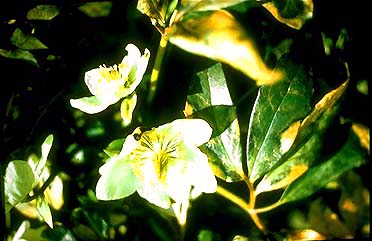
Picture 1. Helleborus niger
Introduction - availability
Seasonal decoration often brings plants and flowers into our homes, including homes that normally lack the year round green oasis that house plants provide. The distribution of Christmas decorative plants is thereby broader than that of regular house plants. Unfortunately, many of these plants are toxic and provide a hazard to our playful family members.Their often attractive appearance increases the likelihood of being eaten by children. For pets the risk is greater simply due to increased availability. Thus, we would like consumers to be aware of the threat that their beautiful Christmas decorations might provide if attention is not paid to keeping these plants out of the reach of children and pets.
In Europe Helleborus niger is considered one of the most traditional and noble seasonal plants of the Christmas time. Serious poisoning following ingestion is rare.
The knowledge of the powerful toxicity or rather the medicinal potential of Christmas rose goes back to the Middle Ages, when it was extensively used by herbalists, and even to earlier times. Theophrastus (Greek philosopher, c. 372-287 BC., "the father of Botany") and Dioscorides (Greek physician, 1st century AD., author of De Materia Medica) have mentioned Christmas rose in their works. Pliny has mentioned the use of H. niger as early as in 1400 BC. by a soothsayer and physician Melampus, after whom the plant has sometimes been referred to as "melampode".
Description of the plant
Classification and nomenclature
Botanically, Christmas rose is classified to belong to the plant family
Ranunculacae - the Buttercup Family, in which it fits well having
the characteristic flower and fruit morphology. The scientific name
Helleborus derives from the Greek name for H. orientalis
"helleboros"; "elein" to injure and "bora" food. Niger refers to the
black color of the roots of the Christmas rose plant. The name
Helleborus niger was given to the plant by Carl von Linné.
Common names of H. niger include black hellebore, Christmas rose and
Easter rose (Finnish: jouluruusu, Swedish: Julros, German: Schwarze
Nieswurz, Christrose, French: Hellébore noir, Rose de Noel, Italian:
Elleboro nero, Fava di lupo, Rosa di Natale.
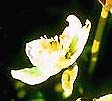
Characteristics
Christmas rose is an evergreen rhizomatous perennial reaching 35 cm
(13,5 in.) in height. In its native habitat, the Christmas rose flowers from
December through April, the season when snow is escaping leaving open
spots
for the first spring makers to grow, each clump producing groups of 2 or 3
large nodding flowers. By the end of and during the flowering season part
of the old leaves die (lasting only for one year) and new ones begin to
grow. Also the new flower buds are formed within the short growth season,
generally from February through May. The growth season of Christmas rose
is
thus short; four to five months.
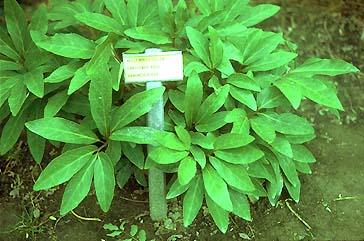
Picture 2. H. niger in early summer.
H. niger produces a floral stalk but no true leafy stems.
LEAVES: The leaves are basal, persistent, alternate, palmately cleft, with long petioles. They consist of 7-9 leaflets which are dark green, shiny, tough, narrow and lanceolate.
FLOWERS: Very few-flowered; showy flowers, usually borne singly on red-spotted peduncles, are white (suffused in pink), sepals: 5, large petaloid; petals small, turbular, claved; stamens: numerous, the outer 8-10 modified into staminoides; pistils: usually 3 or 4; style: erect, slender.
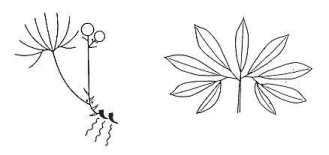
Picture 3. H. niger (graph after Werner and Ebel, 1994)
ROOTS: Rootstock is short, black.
FRUIT: Fruit is a follicle.
Gardening
Christmas rose is cultivated as an ornamental garden plant in temperate
climates. It is a durable, cold-hardy shrub thriving in partially shaded, moist
situations in good soil. It has been introduced throughout the US.
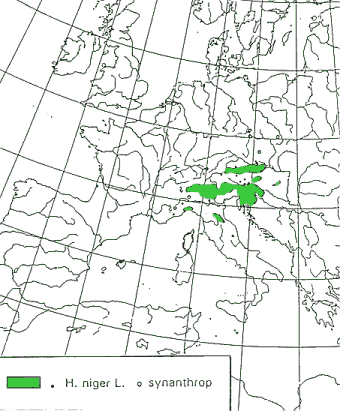
Picture Distribution of H. niger (Werner and Ebel, 1994)
For use as Christmas decoration Christmas roses are propagated both for potted plant and cut flower production.
Distribution
Christmas rose is native to mountainous regions (400-1,800 m - sometimes
even up to 2,300 m) and open woodlands on chalky, porous, stony clay soils
in Southern and Central Europe, particularly in Southern and Eastern Alps,
the Carpathians and Northern Italy. It is often found in the shade of
spruce, birch, oak and beech forests.
Related species
H. viridis green hellebore (sepals are green), winter-aconite
H. foetidus stinking hellebore
H. lividus (lead-colored hellebore)
-
H. corsicus or argutifolius
H. vesicarius
H. orientalis lenten rose
H. purpurascens (purplish hellebore)
H. atroruscens
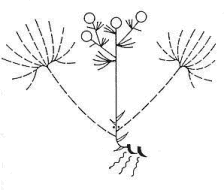
Garden plant; summer green rhizomatous perennial; native in Central and Western Europe: northern Spain and northern Italy through western France and central Germany to southern England; mountainous regions up to 1,600 m (the Alps) or 2,400 (the Pyrennins), mainly in shady warm spots in beech forests, chalky and porous soil; produces an erect stem with 2-4 drooping green flowers.
Cardiotonic effects (helleborin) similar to H. niger, very toxic, violently emetic (causes vomiting), laxative and rubefacient.
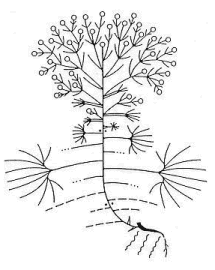
Garden plant, evergreen, relatively short-living perennial; native in South-Western Europe: from southern Italy and southern Spain through western Germany and France to southern England, mountain regions, temperate climate.
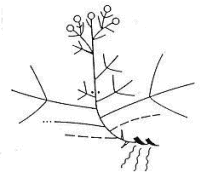
Evergreen rhizomatous perennial; native in Western Mediterranean islands: the Baleares, rocky mountain sides facing north.
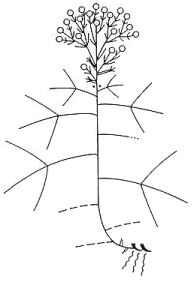
Evergreen rhizomatous perennial; argutifolius refers to sharply toothed leaves; native in Corsica and Sardinia, sunny spots in mountain forests and shady riversides; often mixed with H. lividus.
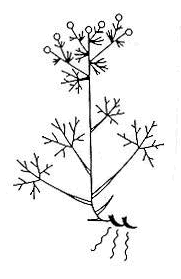
Wintergreen rhizomatous perennial; native from South-Eastern Anatolia to North-Western Syria, hilly regions.
Evergreen rhizomatous perennial, native in South-Eastern Europe (Turkey) and Western Asia (Kaukasus)
Native in Eastern Europe
Flowers are deep read; native in the area of the former Yugoslavia.

Picture: The Phylogenetic tree of Helleborus sp. (Werner and Ebel, 1994)
Phylogenetic tree
Helleborus species are generally divided into two groups:
Caulescentes have elongated, leafy, usually dicyclic stems and they
grow in the mild winter climate of the Mediterranean-Atlantic range. The
group Scapigeri, in which also H. niger belongs to, is
derived from the Caulescentes. Scapigeri have basal leaves
and grow mainly in the submediterranean to south-temperate climates. The
new classification, based on the structural characteristics, divides
hellebores in subfamilies Helleborus and Helleborastum.
Toxicity
The entire Christmas rose-plant is toxic. Out of all the organs particularly the rhizome contains ill-defined compounds. The powerful toxins present are not destroyed in drying or storage. Both animals and humans are affected. Hellebores are said to have a burning taste.
All Helleborus sp. are claimed to be toxic. Some current authors propose lack of the effective cardiac glycosides in H. niger and suggest that the prior knowledge on the presence of these compounds in effective concentrations is derived from the use of preparatives contaminated by H. viridis, the powerful toxicity of which is also currently proven. Whether there is wide diversity in the presence of effective toxins among H. niger strains is not known.
The plants in the family Ranunculaceae contain a variety of powerful toxins. The toxic compounds found in H. niger in addition to cardiac glycosides helleborin, hellebrin and helleborein include saponosides and the ranunculoside derivative, protoanemonine.
- The primary cardiac glycoside present in Helleborus is bufadienole hellebrin.
- Hellebrigenin, the aglycone of hellebrin is more potent than the glycoside itself.
- Treatment for cardiac glycoside poisoning: atropine and activated charcoal, lidocaine for H. viridis.
Hellebore poisoning is rare. Generally, the cardiac glycosides present are responsible for poisonings causing digitalis-like (ref. Digitalis purpurea , foxglove) effects: bradycardia, prolonged P-R interval, idioventicular rhythm, bundle-branch block, venticular fibrillation and asystole. H. viridis, the green hellebore and H. foetidus, the stinking hellebore (both used in garden settings) cause poisoning similar to that of H. niger. Some authors claim that the cardiac symptoms reported are likely to be caused by the other Helleborus species rather than by H. niger. Especially mixing of root preparatives with H. viridis is suggested.
The high amounts of ranunculin or protoanemonin in the leaves (presence agreed by all authors), stems and flowers of H. niger are responsible for the skin (dermatitis, following exposure to bruised root material, leaves, stems and flowers), eye (powdered root) and gastrointestinal irritations (following ingestion): salivation, mouth and throat tingling, abdominal pain, vomiting, purging, diarrhea.
Some authors describe symptoms following ingestion of Christmas rose such as slow, irregular pulse, weakness, labored breathing, irregular heart beat, convulsions, respiratory failure and nervous system disturbances such as delirium, convulsions and even death due to respiratory collapse.
A 38-year old woman has been reported to recover from ingestion of H. viridis buds, that she mistook to be wild asparagus, after administration of lidocaine, magnesium sulfate and potassium chloride.
Medicinal Application
In the ancient times hellebore was an appreciated medicinal plant with miraculous curative effects especially on mental disorders. External treatment of lice is among the ancient uses. It also shares the reputation as a classic poison with hemlock, nightshade and aconite. In Africa it has been used as an arrow poison. For medicinal applications only rhizome is used as a source (Rhizoma Hellebori).
The modern medicine has almost forgotten the curative properties of hellebore. Treating intestinal worms lasted into the 18th century. The only drawback was that the patient might end up being killed together with the worms.
Hellebrigenine has been used as a cardiotonic to complement digitalin and strophanthin. The rhizome is used to treat some skin ulcers. Hellebore preparatives have also been used as an emetic, diuretic, emmenagoge and irritant. In addition, the earlier uses of hellebore include use as a purgative, local anesthetic and abortive. These applications have been abandoned, except in veterinary treatment where a decoction is still used to treat mange.
Homeopathic medicine uses a tincture (= alcoholic extract, the alcohol inhibits enzymes thereby preventing the break down of e.g. protoanemonine) prepared from the rhizome to treat eclampsia, epilepsy, certain psychoses, and to combat meningitis and encephalitis.
Legends
One of the many legends around Christmas rose tells a story of a country girl named Madelon. She visits the Christ child in Betlehem, but is sad for not having a gift to bring him. An angel that sees her sadness, brings her outside and touches the ground. The first Christmas rose arises on the spot touched by the angel. Madelon now has a gift to bring.
Other toxic Christmas decorations
Holly Ilex aquifolium

Lily of the Valley Convallaria majalis
Mistletoe Viscum album
Poinsettia Euphorbia pulcherrima
The evergreen leaves are dark and shiny, together with the bright red berries they make a popular Christmas decoration.
The plant contains several glycosides, such as a bitter compound, ilicin. The leaves contain theobromine (also present in tea), which affects the heart. Only little is known about other toxins (saponins, triterpene compounds) present in this plant or of their toxic action. The red berries, not uncommonly eaten by children at the Christmas time, are toxic. When eaten in greater numbers, persistent vomiting and diarrhea follows. Two berries is reported to cause nausea. 20-30 berries has suggested to be fatal, but no reported cases exist. If a child eats more than 2 to 3 berries induced vomiting as soon as possible is recommended.
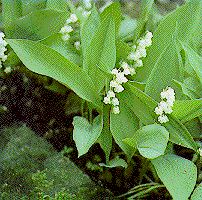
Used for its delicate appearance and strong beautiful fragrance. In nature lily of the valley blooms in late May - June, at Christmas time it brings delights of the summer in our minds.
The entire plant contains powerful glycosides: convallarin, convallatoxin, convallamarin among others, and also toxins from other groups like saponosides. The toxins of this plant have cardiotonic, antispasmodic, purgative and diuretic properties. Most toxifications result from ingestion of the attractive red berries by children. Drinking of the vase water has also caused poisoning.
Reported symptoms following ingestion of parts of the lily of the valley plant include: burning of the mouth and throat, nausea, vomiting and abdominal pain; headache, dilated pupils, mental disturbance, decreased pulse rate, irregular or slow heart beat, clammy skin, collapse, coma, circulatory failure and even death due to heart failure. Serious poisoning is rare, vomiting limits the adsorption of the toxins.
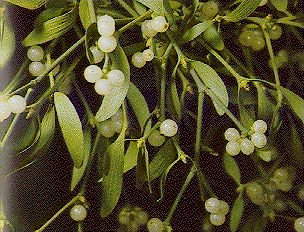
Haven't we all kissed under the mistletoe?
The toxic compounds found in mistletoe are proteins viscotoxin A and B. Leaves and stems are said to be more toxic than the white decorative berries.
Mistletoe is a partial parasite growing on many types of trees. Interestingly its toxicity varies upon the tree it grows on.
Children sometimes eat the berries leading to mild to severe stomach ache. Reactions following mistletoe ingestion are very variable, serious toxifications are rare but even fatal poisonings have been reported both for human and pets. Suggested treatment: induced vomiting.
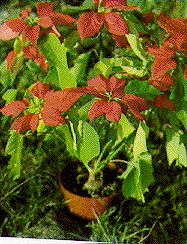
Used as Christmas decoration due to colourful leaves just beneath the small actual flowers. The milky sap, characteristic to the broad family of Euphorbiaceae contains poisonous diterpene esters that are persistent even when dried.
Poinsettias are often mentioned to be highly toxic, however, the recent studies have failed to show toxic effects. It should nevertheless be kept in mind that toxicity of any substance is subject to dose. Whether high variation in toxicity within poinsettia strains and susceptibility within individuals exist is not known and thus carefulness is suggested. Nausea, burning of the mouth and vomiting has been reported to have followed accidental ingestion of poinsettia by some children, others remaining symptomless. A dog has reported to gain fatal poisoning after poinsettia ingestion. Never ignore the risk of small children and pets ingesting plants in their reach.
References
Literature cited in this work:
BOOKS
Alber, J.I. and Alber, D.M., Baby Safe House plants and Cut Flowers - A Guide to Keeping Children and Plants Safely Under the same Roof, Storey Communications, Inc., Vermont 1993, 188 p.
Coombes, A.J., Dictionary of Plant Names, Timber Press, Portland (Oregon) 1994, 195 p.
Cooper, M.R. and Johnson, A.W., Poisonous Plants and Fungi - An Illustrated Guide, Ministry of Agriculture, Fisheries and Food, HMSO, 3rd ed., London 1994, 134 p.
Hill, R.J. and Folland, D., Poisonous Plants of Pennsylvania, Pennsylvania Department of Agriculture, Harrisburg 1986, 175 p.
Schauenberg, P. and Paris, F., Guide to Medicinal Plants, Keats Publishing Inc., New Canaan (Connecticut) 1990, 349 p.
Westbrooks, R.G. and Preacher, J.W., Poisonous Plants of Eastern North America, University of South Carolina Press, 1986, p.
ARTICLES
Gelmetti, P., L'elleboro (cenni storici), Policlinico. Sezione pratica, 75 (1968) 596-599
Werner, K. and Ebel, F., Zur Lebensgeschichte der Gattung Helleborus L. (Ranunculaceae), Flora 189 (1994) 97-130
Links to related web pages